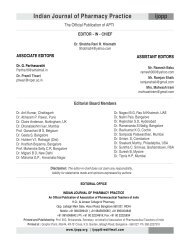Oct-Dec, 2011 - Indian Journal of Pharmacy Practice
Oct-Dec, 2011 - Indian Journal of Pharmacy Practice
Oct-Dec, 2011 - Indian Journal of Pharmacy Practice
- No tags were found...
You also want an ePaper? Increase the reach of your titles
YUMPU automatically turns print PDFs into web optimized ePapers that Google loves.
Dinesh KU - Evaluation <strong>of</strong> the Impact <strong>of</strong> a Pharmaceutical Care Program for Diabetes Patients in Nepal: A Preliminary Studysulfonylureas 12 (33.33%) and Insulin 5(13.88%). A studyfrom South Africa, Nepal and India and they also had the23,24,19similar type <strong>of</strong> finding. The choice <strong>of</strong> antidiabeticdepends on the type <strong>of</strong> patients, their concurrent illness, costfactors, as well as the availability <strong>of</strong> medicines. In general,biaguanides is considered as a safer drug in terms <strong>of</strong>hypoglycemia and hence to be preferred drug specially inobese patients.In the present study, there was an encouraging result found onimprovement in fasting and post prandial glucose level indiabetics. The satisfactory glycemic control was found in TG-2 patients. This improvement in glycemic control in TG-2patients might be due to an effective demonstration <strong>of</strong>diabetic kit apart from other educational intervention. A studyfrom Thailand about effect <strong>of</strong> counseling on glycemic controlfor six months duration and found that there was significantimprovement in glycemic control between the control and test25group subjects. A study from South India also stressed thateffective counseling and education program can improve the26glycemic level significantly in diabetics.Awareness about diabetes by counseling and educationalprogram in diabetics makes them more focus and alert to theirdisease management which brings down their economyburden significantly. In present study, it was found that directcost incurred by diabetics in all three groups during the studyperiod was more at initial stage (baseline) and reducedsignificantly after 2 months intervention. More cost initiallywas due to more prescribing <strong>of</strong> antidiabetic andcardiovascular drugs, unawareness <strong>of</strong> disease andhospitalization due to serious problem. But significantreduction in expenses in diabetics came down afterintervention in TG-2 and TG-1 patients but more reductionwas found in control group patients, it might be due toreduction in frequency <strong>of</strong> hospitalization which was foundmore initially in CG patients. A study from Denmark on cost<strong>of</strong> diabetes and diabetes care also found the significant cost27incurred by diabetics in disease management.Improvement in health related problems in diabetics makesthem more satisfied to the services provided to them for theirdisease management. Present study also focused on patientsatisfaction level to pharmaceutical care program at baselineand after intervention. Significant improvement insatisfaction level was found in patients to pharmaceutical careservices provided to them. The level was more in TG-2 ascompare to TG-1 patient. A slight increase in satisfaction levelin control group patients was also seen due to informationreceived by drug prescriber about antidiabetic drugs use fortheir normal care. A study also had the similar concurrence inpatient satisfaction level due to the effect <strong>of</strong> pharmaceutical28care program.STUDY LIMITATIONS AND STRENGTHSThis study was conducted with very less number <strong>of</strong> diabetespatients within less time period. Therefore, it can not begeneralized to overall diabetic population.Moreover, thestudy enrolled the patients (total 31 patients) only from onehospital from one development region <strong>of</strong> Nepal and hence cannot be generalized to the diabetic population <strong>of</strong> Nepal. It wasalso seen from the study that few patients did not come back ordelayed their follow up in the hospital due to their financialconstraint. This was the first preliminary interventional studyconducted in Nepal in the area <strong>of</strong> diabetes awareness. Thisstudy provided the primary information about the level <strong>of</strong>awareness about diabetes in Nepali population. This studycould be a corner stone for further study in the same area inlarge number population for longer duration.CONCLUSIONThis study identified the impact <strong>of</strong> pharmaceutical careprogram in improvement <strong>of</strong> knowledge, attitude and practiceabout diabetes in diabetics. Significant improvement wasfound in TG-1 patients and TG-2 patients in terms <strong>of</strong> theirknowledge improvement after the intervention. TG-2 patientalso shown significant improvement in their attitude andpractice as compare to TG-1 patients. The study wassuccessful in finding the prescribing pattern <strong>of</strong> antidiabeticsin a Nepalese teaching Hospital. Incidence <strong>of</strong> polypharmacyin diabetes patients was found to be high. Demonstration <strong>of</strong>diabetic kit combined with counseling and education programhad shown the significant effect in glycemic control <strong>of</strong> TG-2patient as compare to TG-1 patients. The present studyhighlighted the impact <strong>of</strong> pharmaceutical care program inreduction <strong>of</strong> economy burden to patients. Patient satisfactionlevel can be increased by providing proper healthcare servicesand improvement in their health related problems. Significantimprovement in satisfaction level was found in TG-2 and TG-1 patients after proper pharmaceutical care provided to them.ACKNOWLEDGMENTSThe author acknowledge to Mr.Tek Bahadur B.K whoassisted in data collection and compilation. Mr. Tek BahadurB.K is attached with Manipal Teaching Hospital where heworks as pharmacist in department <strong>of</strong> Hospital and Clinical<strong>Pharmacy</strong>, Pokhara, Nepal. We would also like to thank toDean, Manipal College <strong>of</strong> Medical Sciences who had giventhe permission to conduct the study in Manipal TeachingHospital. Authors wish to thank all the patients for theirparticipation and co-operation in the study.Conflict <strong>of</strong> interest: Authors would like to declare <strong>of</strong> noconflict <strong>of</strong> interest associated with this study.<strong>Indian</strong> <strong>Journal</strong> <strong>of</strong> <strong>Pharmacy</strong> <strong>Practice</strong> Volume 4 Issue 4 <strong>Oct</strong> - <strong>Dec</strong>, <strong>2011</strong> 60
















